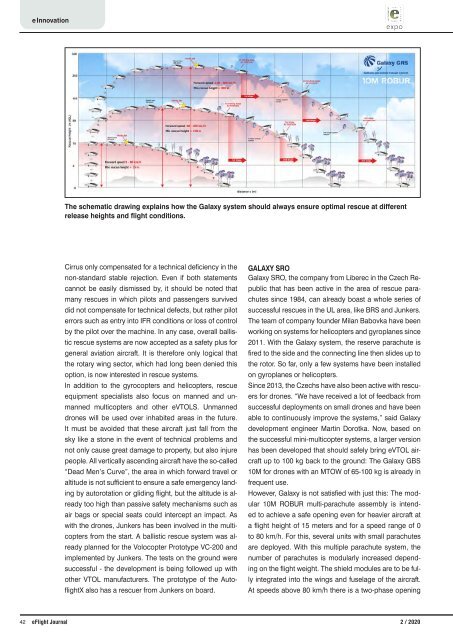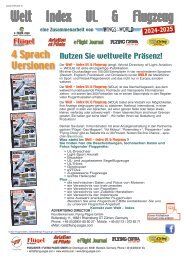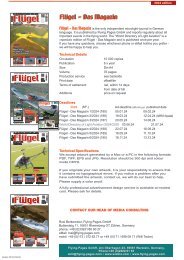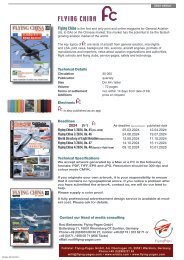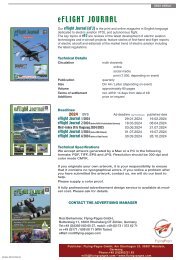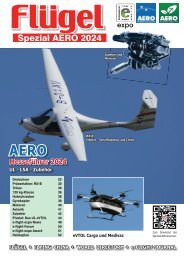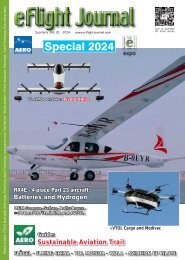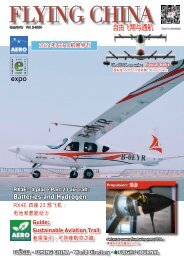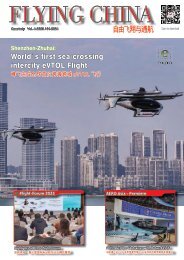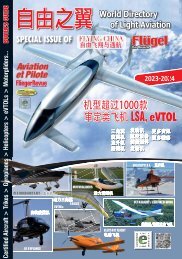eFlight Journal 02-2020
E-Flight Journal 2-2020
E-Flight Journal 2-2020
- No tags were found...
Create successful ePaper yourself
Turn your PDF publications into a flip-book with our unique Google optimized e-Paper software.
e Innovation<br />
The schematic drawing explains how the Galaxy system should always ensure optimal rescue at different<br />
release heights and flight conditions.<br />
Cirrus only compensated for a technical deficiency in the<br />
non-standard stable rejection. Even if both statements<br />
cannot be easily dismissed by, it should be noted that<br />
many rescues in which pilots and passengers survived<br />
did not compensate for technical defects, but rather pilot<br />
errors such as entry into IFR conditions or loss of control<br />
by the pilot over the machine. In any case, overall ballistic<br />
rescue systems are now accepted as a safety plus for<br />
general aviation aircraft. It is therefore only logical that<br />
the rotary wing sector, which had long been denied this<br />
option, is now interested in rescue systems.<br />
In addition to the gyrocopters and helicopters, rescue<br />
equipment specialists also focus on manned and unmanned<br />
multicopters and other eVTOLS. Unmanned<br />
drones will be used over inhabited areas in the future.<br />
It must be avoided that these aircraft just fall from the<br />
sky like a stone in the event of technical problems and<br />
not only cause great damage to property, but also injure<br />
people. All vertically ascending aircraft have the so-called<br />
“Dead Men’s Curve”, the area in which forward travel or<br />
altitude is not sufficient to ensure a safe emergency landing<br />
by autorotation or gliding flight, but the altitude is already<br />
too high than passive safety mechanisms such as<br />
air bags or special seats could intercept an impact. As<br />
with the drones, Junkers has been involved in the multicopters<br />
from the start. A ballistic rescue system was already<br />
planned for the Volocopter Prototype VC-200 and<br />
implemented by Junkers. The tests on the ground were<br />
successful - the development is being followed up with<br />
other VTOL manufacturers. The prototype of the AutoflightX<br />
also has a rescuer from Junkers on board.<br />
GALAXY SRO<br />
Galaxy SRO, the company from Liberec in the Czech Republic<br />
that has been active in the area of rescue parachutes<br />
since 1984, can already boast a whole series of<br />
successful rescues in the UL area, like BRS and Junkers.<br />
The team of company founder Milan Babovka have been<br />
working on systems for helicopters and gyroplanes since<br />
2011. With the Galaxy system, the reserve parachute is<br />
fired to the side and the connecting line then slides up to<br />
the rotor. So far, only a few systems have been installed<br />
on gyroplanes or helicopters.<br />
Since 2013, the Czechs have also been active with rescuers<br />
for drones. “We have received a lot of feedback from<br />
successful deployments on small drones and have been<br />
able to continuously improve the systems,” said Galaxy<br />
development engineer Martin Dorotka. Now, based on<br />
the successful mini-multicopter systems, a larger version<br />
has been developed that should safely bring eVTOL aircraft<br />
up to 100 kg back to the ground: The Galaxy GBS<br />
10M for drones with an MTOW of 65-100 kg is already in<br />
frequent use.<br />
However, Galaxy is not satisfied with just this: The modular<br />
10M ROBUR multi-parachute assembly is intended<br />
to achieve a safe opening even for heavier aircraft at<br />
a flight height of 15 meters and for a speed range of 0<br />
to 80 km/h. For this, several units with small parachutes<br />
are deployed. With this multiple parachute system, the<br />
number of parachutes is modularly increased depending<br />
on the flight weight. The shield modules are to be fully<br />
integrated into the wings and fuselage of the aircraft.<br />
At speeds above 80 km/h there is a two-phase opening<br />
42 e Flight <strong>Journal</strong><br />
2 / 2<strong>02</strong>0


